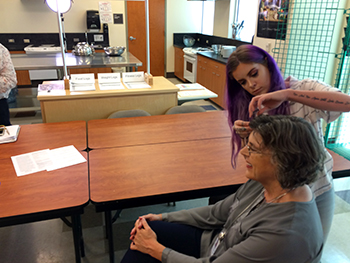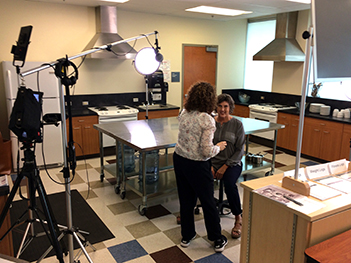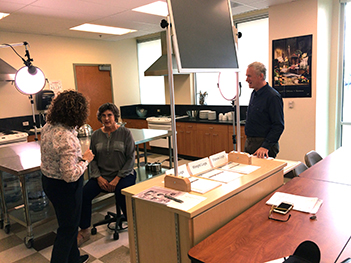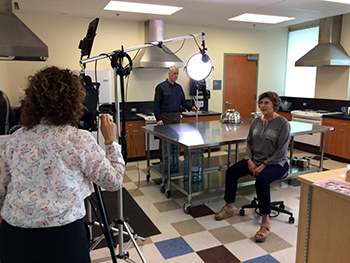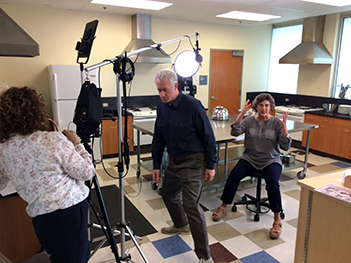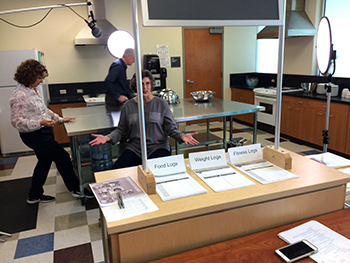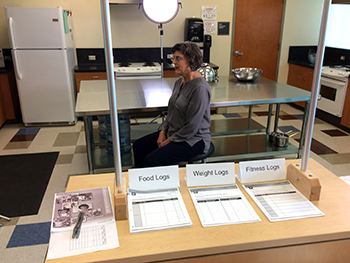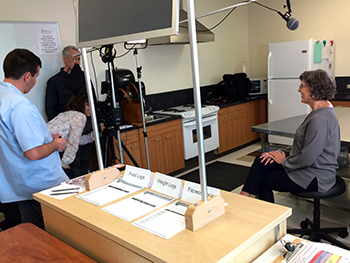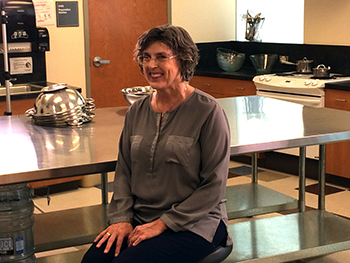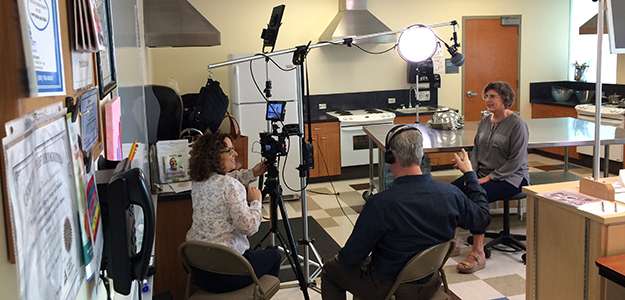 Several University of Arizona Department of Medicine faculty physicians participated in filming this fall of educational videos for the start-up video-based informational website, Doctorpedia™, that educates online health-care seekers and connects them with doctors and fellow patients.
Several University of Arizona Department of Medicine faculty physicians participated in filming this fall of educational videos for the start-up video-based informational website, Doctorpedia™, that educates online health-care seekers and connects them with doctors and fellow patients.
 In mid-October, Merri Pendergrass, MD, PhD (pictured right), a professor of medicine, clinical chief for the UA Division of Endocrinology, Diabetes and Metabolism, and director of the Adult Diabetes Program at Banner – University Medical Center Tucson and South, was engaged in filming videos discussing various care aspects for diabetes patients. A mini-photo gallery of that videotaping session is available at the bottom of this article.
In mid-October, Merri Pendergrass, MD, PhD (pictured right), a professor of medicine, clinical chief for the UA Division of Endocrinology, Diabetes and Metabolism, and director of the Adult Diabetes Program at Banner – University Medical Center Tucson and South, was engaged in filming videos discussing various care aspects for diabetes patients. A mini-photo gallery of that videotaping session is available at the bottom of this article.
Dr. Pendergrass said she saw great value in the videos as often during the crush of modern medicine, the leisure available to fully explain what a patient may be facing and the lifestyle changes they’ll have to make gets away pretty quickly. A sample of her video can be found here:
Alternative link to sample videos: https://vimeo.com/search?q=doctorpedia
Among others who’ve participated (with their subspecialties) include Janet Campion, MD, MPH (pulmonary); Steve Klotz, MD (infectious diseases); Eugene Trowers, MD, MPH; (gastroenterology); and Joseph Alpert, MD (cardiology). See a DoctorPedia promotional video featuring Drs. Alpert, Klotz and Trowers (among other Tucson physicians) here.
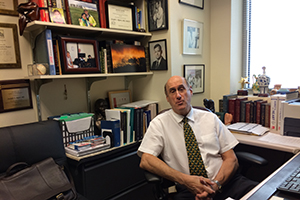 Dr. Alpert (pictured right), a cardiologist with the UA Sarver Heart Center, former department chair, and editor-in-chief of the American Journal of Medicine, the official journal of the Alliance for Academic Internal Medicine, is the local recruiter on the project. He met Jeremy Wosner, the British entrepreneur who launched the recently reorganized firm behind the videos, a few years ago while giving a lecture at Cedars-Sinai Medical Center in Los Angeles, where Wosner now lives.
Dr. Alpert (pictured right), a cardiologist with the UA Sarver Heart Center, former department chair, and editor-in-chief of the American Journal of Medicine, the official journal of the Alliance for Academic Internal Medicine, is the local recruiter on the project. He met Jeremy Wosner, the British entrepreneur who launched the recently reorganized firm behind the videos, a few years ago while giving a lecture at Cedars-Sinai Medical Center in Los Angeles, where Wosner now lives.
Serving as a medical advisor to Doctorpedia, Dr. Alpert has since done several videos, mostly on cardiovascular health issues. Each is at least 20 minutes in length. They serve, he notes, to fill in the educational gaps for patients from physicians who in these times of maximizing access to care and keeping up with electronic medical record (EMR) requirements have less time for longer appointments to go over as many details in what their charges can expect, how they can better manage their health conditions and other implications in how their care needs may affect their lives going forward.
“It’s advice. There’re all sorts of questions that come up. One of my very good friends, an English professor here, had a fainting spell and just got a pacemaker. Already I’ve had four emails from him: ‘What about this, Joe?’ or ‘What about that?’ Well, most doctors are not answering that. They don’t have the time. They’ve had to speed up everything since the EMR takes so much more time today.
“On the other hand, if a physician can say, ‘Hey, go look at this video. It’ll tell you everything I want to tell you. Check back with me if you’ve got any questions afterward.’ That’s absolutely perfect for today’s busy doctors. That’s why this is a good idea. It’s very important. That’s why I agreed to recruit people.”
 Dr. Trowers, who is working on a book, Gut Feelings (on how patients can get the best out of doctor-patient encounters for gastrointestinal disorders), with the UA College of Medicine - Tucson's Marc Tischler, PhD, and Karen Spear-Ellinwood, PhD, said he saw an immediate connection in that both it and the videos seek to impart information in a way that's easily understood.
Dr. Trowers, who is working on a book, Gut Feelings (on how patients can get the best out of doctor-patient encounters for gastrointestinal disorders), with the UA College of Medicine - Tucson's Marc Tischler, PhD, and Karen Spear-Ellinwood, PhD, said he saw an immediate connection in that both it and the videos seek to impart information in a way that's easily understood.
"It’s the same goal. We’re trying to imprint the information on patients in a way they can grasp quickly and easily. With the videos, you get an easy format where patients can turn one on and digest it in chunks," said Dr. Trowers. He's impressed by the videography team who come from Los Angeles and have a number of national commercials to their credit. Being associated with such high quality videos, he added, is good for the physician as well as the university. "They make these succinct and to the point, but with a lot of good information."
All the filming is done in non-clinical areas and, in some cases, even in a physician’s home. The settings are professional, but nondescript without mention of Banner – University Medical Center or the University of Arizona beyond the titles listed onscreen for each doctor. Physicians receive a $300 stipend per video.
“Jeremy’s already got a couple hundred of these interviews,” Dr. Alpert said. “Some physicians are in private practice. Some are at Cedars-Sinai, some in Boston, some in St. Louis, some here.”
He added that Wosner has twice won funding from venture capitalist groups and has been pursuing potential sponsorships from Google, Facebook and Comcast, “There’s a lot of interest and I think it’s going to fly.” He would like to see the videos broadened to other languages like Spanish or Chinese, for which his wife, Qin Chen, PhD, a professor in the UA Department of Pharmacology, has done some filming for Doctorpedia.
Similar videos, although typically 5-15 minutes in length, used to appear on the old UAHealth.com website for the University of Arizona Health Network (UAHN)—now Banner – University Medicine after its February 2015 merger with Banner Health—in English and Spanish. Subscription to the videos was funded by a grant won by Donna Beifus, RN, then a UAHN nursing director and now chief administrative officer for care management at UC San Diego Health.
Learn more about the videos and the company here: https://doctorpedia.com
PHOTO GALLERY:
